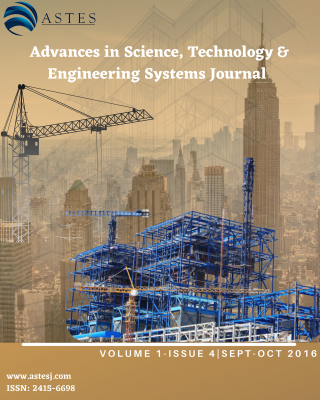
Download Complete Issue
Current Issue features key papers related to multidisciplinary domains involving complex system stemming from numerous disciplines; this is exactly how this journal differs from other interdisciplinary and multidisciplinary engineering journals. This issue contains 2 accepted papers in civil engineering domain.
Editorial
Front Cover
Adv. Sci. Technol. Eng. Syst. J. 1(4), (2021);
Editorial Board
Adv. Sci. Technol. Eng. Syst. J. 1(4), (2021);
Editorial
Adv. Sci. Technol. Eng. Syst. J. 1(4), (2021);
Table of Contents
Adv. Sci. Technol. Eng. Syst. J. 1(4), (2021);
Articles
Civil Engineering
Compressive Strength of Cement Mortar blended with Coconut Fibers and Human Hair
Ibrar Ahmad, Fayaz Ahmad, Shah Room, Zubair Abdullah, Muhammad Ihsan
Adv. Sci. Technol. Eng. Syst. J. 1(4), 1-4 (2016);
View Description
Mortar is used all over the world for construction purpose. It consists of cement paste and fine aggregates and admixtures if required are also incorporated to modify some of its properties. In this study coconut fibers and human hair were used as an additive materials in the mortar and its effects on compressive strength of the mortar were investigated. Coconut fibers and human hair are waste materials which are produced in millions of tons every year which create not only biodegradability problems but also cause pollution. Coconut fibers and human hair were used as additive materials in mortar in 2, 4 and 6 % to prepare blended mortar. Mortar samples of coconut fibers and human hair were prepared and compared with each other and control samples. Cement to sand ratio was kept 1:3 with water cement ratio of 0.6 for all mixes. Cubes having dimensions of 2×2×2 inches were used in this project. All the mixes were cured at normal room temperature for 3, 7 and 28 days. Results revealed that mix with 4% coconut fibers showed higher compressive strength at 3 days and 6% higher compressive strength at 28 days. With increase of coconut fibers compressive strength increased. However, mortar with human hair initially shows higher strength when 2 % was incorporated but with increasing percentage of human hair, strength was reduced. With addition of mix fibers i.e. coconut fibers and human hair into the mix, the compressive strength initially increased at 3rd day of curing, showing higher compressive strength at 3 days for all percentages of mix compare to reference mortar, however with further increase of percentage of mix fibers into the mortar, the compressive strength was reduced showing lowest compressive strength at 28th days for 4% of mix fibers i.e. coconut fibers and human hair.
Water Resources
Temperature Trend Detection in Upper Indus Basin by Using Mann-Kendall Test
Ateeq Ur Rauf, Muhammad Salman Rafi, Irshad Ali, Uzair Wali Muhammad
Adv. Sci. Technol. Eng. Syst. J. 1(4), 5-13 (2016);
View Description
Global warming and Climate change are commonly acknowledged as the most noteworthy environmental quandary the world is undergoing today. Contemporary studies have revealed that the Earth’s surface air temperature has augmented by 0.6°C – 0.8°C in the course of the 20th century, together with alterations in the hydrological cycle. This study focuses on detecting trends in seasonal temperature for the five selected stations in the Upper Indus Basin. The Mann-Kendall test was run at 5% significance level on time series data for each of the five stations during the time period, 1985 to 2014. The Standard Test Statistic (Zs) indicates the presence of trend and whether it is increasing or decreasing. The analysis showed an increasing trend in mean monthly temperature at Astore, Gilgit and Gupiz in March and a decreasing trend for Astore, Drosh, Gilgit and Skardu in September. Gilgit and Gupiz showed unexpected increasing trend in October. This study concludes that the temperature starts increasing in March and stays elevated till the month of June and starts rising again in October thus resulting in expansion of summer season and prolonged glacial melting.
